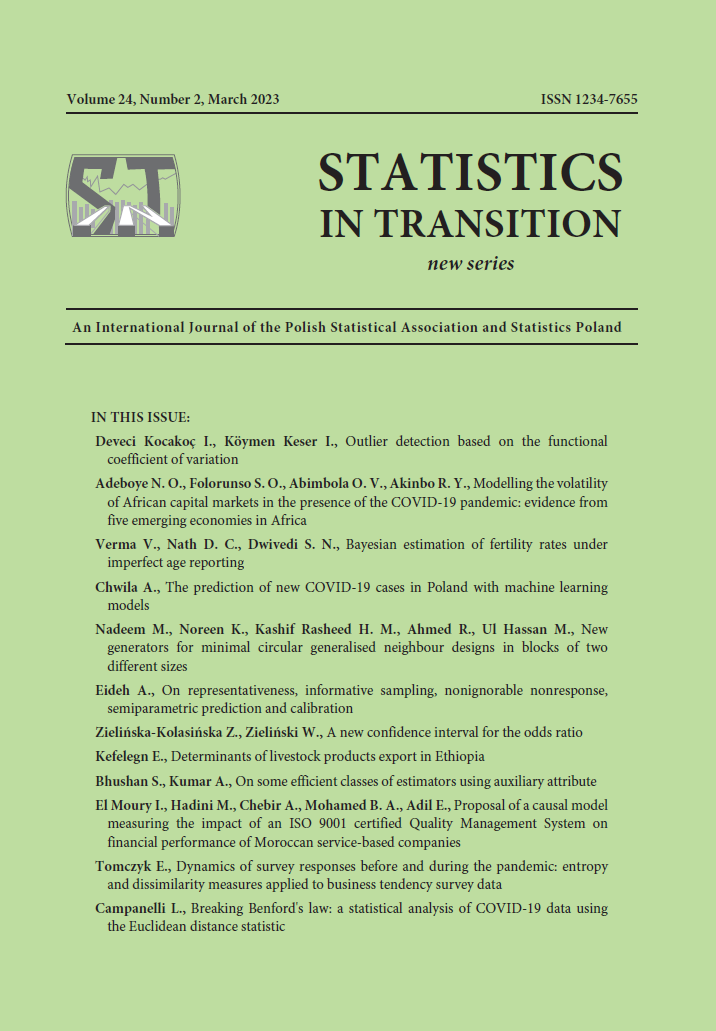ARTICLE
ABSTRACT
This article is set within the framework of studies focusing on the impact of the SARS-CoV-2 virus on the dynamics of economic activity. For the purposes of the analysis of the expectations expressed in business tendency surveys, the paper aims to verify whether the pandemic of 2020-2022 can be seen as just another contraction phase. Entropy and dissimilarity measures are employed to study the characteristics of the expectations and assessments expressed in the business tendency survey of Polish manufacturing companies. The empirical results show that the dynamics of the manufacturing sector data, particularly as far as general economic conditions are concerned, set the pandemic period apart. The economic consequences of the COVID-19 pandemic expressed in business tendency surveys tend to be unfavourable, but the statistical properties or the degree of the concentration of respondents’ answers do not correspond closely either to the expansion or contraction phases of the business cycle.
KEYWORDS
business cycles, survey data, expectations, manufacturing industry, COVID-19 pandemic.
REFERENCES
Adamowicz, E., Walczyk, K., (2022). Koniunktura w przemyśle. Luty 2022, Badanie okresowe, nr 401, Instytut Rozwoju Gospodarczego, Szkoła Główna Handlowa, Warszawa.
Bartik, A. W., Bertrand, M., Cullen, Z., Glaeser, E. L., Luca, M., Stanton, C., (2020). The impact of COVID-19 on small business outcomes and expectations, PNAS, vol. 117 (30), pp. 17656–17666.
Boianovsky, M., Erreygers, G., (2021). How Economists Ignored the Spanish Flu Pandemic in 1918–1920, Erasmus Journal for Philosophy and Economics, vol. 14, no. 1.
CDC, (2021). 1918 Pandemic (H1N1 virus), https://www.cdc.gov/flu/pandemicresources/ 1918-pandemic-h1n1.html [access: April 17, 2022].
Chomątowski, S., Sokołowski, A., (1978). Taksonomia struktur, Przegląd Statystyczny, vol. 2, pp. 217–226.
GUS, (2022). Business tendency in manufacturing, construction, trade and services 2000–2022, GUS (Statistics Poland), Warszawa.
Meyer, B. H., Prescott, B., Sheng, X. S., (2022). The impact of the COVID-19 pandemic on business expectations, Journal of Forecasting, vol. 38, pp. 529–544.
Shannon, C. E., (1948). A mathematical theory of communication, The Bell System Technical Journal, vol. 27, pp. 379–423, 623–656.
Teresiene, D., Keliuotyte-Staniuleniene, G., Liao, Y., Kanapickiene, R., Pu, R., Hu, S., Yue, X.-G., (2021). The Impact of the COVID-19 Pandemic on Consumer and Business Confidence Indicators, Journal of Risk and Financial Management, vol. 14(4), p. 159.
Theil, H., (1967). Economics and Information Theory, North-Holland Publishing Company, Amsterdam.
Tomczyk, E., (2011). Oczekiwania w ekonomii: idea, pomiar, analiza, Szkoła Główna Handlowa, Warszawa.
Tomczyk, E., (2022). Do Survey Responses in Manufacturing Fluctuate with Business Cycle? Evidence from Poland, w: Białowąs S. (red.) Economic tendency surveys and economic policy - measuring output gaps and growth potentials, Wydawnictwo Uniwersytetu Ekonomicznego w Poznaniu, pp. 71–84.
Van Der Wielen, W., Barrios, S., (2021). Economic sentiment during the COVID pandemic: Evidence from search behaviour in the EU, Journal of Economics and Business, vol. 115.
Wędrowska, E., (2010). Oczekiwana ilość informacji o zmianie struktur jako miara niepodobieństwa struktur, Acta Universitatis Nicolai Copernici, vol. 397, pp. 99–109.
The World Bank, (2021). Polska gospodarka powraca na ścieżkę wzrostu, pomimo problemów z pandemią, Polish Economy Returns to Growth Amidst Pandemic- Related Setbacks (worldbank.org) [access: April 17, 2022].
Worldometer, (2022). COVID-19 Coronavirus Death Toll, https://www.worldometers.info/ coronavirus/coronavirus-death-toll/ [access: April 17, 2022].
Zhang, Q.-S., Jiang, Y.-J., (2008). A note on information entropy measures for vague sets and its applications, Information Sciences, vol. 178, pp. 4184–4191.
